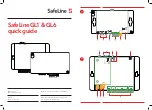
Networks and Routing Basics
B-1
Appendix B
Networks and Routing Basics
This chapter provides an overview of IP networks, routing, and firewalls.
Basic Router Concepts
Large amounts of bandwidth can be provided easily and relatively inexpensively in a local area
network (LAN). However, providing high bandwidth between a local network and the Internet can
be very expensive. Because of this expense, Internet access is usually provided by a slower-speed
wide-area network (WAN) link such as a cable or DSL modem. In order to make the best use of the
slower WAN link, a mechanism must be in place for selecting and transmitting only the data traffic
meant for the Internet. The function of selecting and forwarding this data is performed by a router.
What is a Router?
A router is a device that forwards traffic between networks based on network layer information in
the data and on routing tables maintained by the router. In these routing tables, a router builds up a
logical picture of the overall network by gathering and exchanging information with other routers
in the network. Using this information, the router chooses the best path for forwarding network
traffic.
Routers vary in performance and scale, number of routing protocols supported, and types of
physical WAN connection they support. The Model DG814 DSL Modem Internet Gateway is a
residential or small office router that routes the IP protocol over a single-user ADSL connection.
Summary of Contents for DG814 - DSL Modem Internet Gateway
Page 4: ...iv...
Page 10: ...x...
Page 14: ......
Page 20: ...Reference Manual for the Model DG814 DSL Modem Internet Gateway 1 6 Introduction...
Page 40: ...Reference Manual for the Model DG814 DSL Modem Internet Gateway 3 12 Preparing Your Network...
Page 64: ...Reference Manual for the Model DG814 DSL Modem Internet Gateway 5 10 Maintenance...
Page 108: ...4 Index World Wide Web 1 iii...
















































